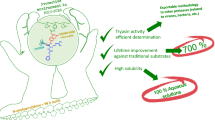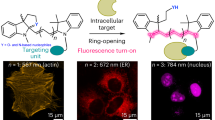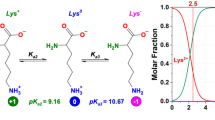Abstract
Several fluorescent substances having two amino groups in their molecules were dissolved in aqueous phase and allowed to react with acid dichlorides and a diisocyanate dissolved in organic phase to give fluorescent polymers; interfacial techniques were used. The infrared spectra of the products showed the absorption bands characteristic of amide linkage, indicating the formation of polymers. Viscosity measurements of aqueous solutions of the products revealed that they behave as polyelectrolytes in water. The fluorescence spectrum, fluorescence intensity, and light resistance were also measured for these polymers and compared with those of the fluorescent monomers used. In the case where a long conjugated system was formed as a result of polymerization, the fluorescent polymers obtained were more light resistant than the corresponding fluorescent monomers.
Similar content being viewed by others
Log in or create a free account to read this content
Gain free access to this article, as well as selected content from this journal and more on nature.com
or
References
M. Shiba, H. Hiramasu, H. Nakano, Y. Kawano, Y. Shigeri, and T. Kondo, Polym. J., 4, 366 (1973).
Z. Yoshida, S. Inoue, and R. Oda, Kogyo Kagaku Zasshi (J. Chem. Soc. Japan, Ind. Chem. Sect.), 56, 44 (1953).
R. M. Fuoss and U. P. Straus, J. Polym. Sci., 3, 602 (1948).
M. Koishi, N. Fukuhara, and T. Kondo, Chem. Pharm. Bull., 17, 804 (1969).
Y. Yamashita, J. Synth. Org. Chem., 28, 1025 (1970).
Y. Yamashita, J. Synth. Org. Chem., 29, 519 (1971).
E. Rabinowitch, J. Am. Chem. Soc., 63, 69 (1941).
Author information
Authors and Affiliations
Rights and permissions
About this article
Cite this article
Uno, A., Kondo, T. Synthesis of Fluorescent Polymers by Interfacial Polymerization Reactions. Polym J 6, 267–273 (1974). https://doi.org/10.1295/polymj.6.267
Issue date:
DOI: https://doi.org/10.1295/polymj.6.267



